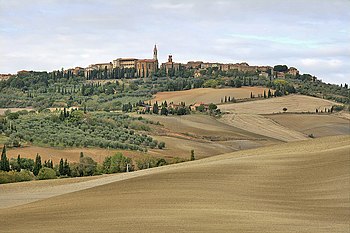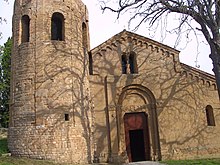Pienza is a city in the Val d'Orcia region of Tuscany. A UNESCO World Heritage Site, it is considered the "touchstone of Renaissance urbanism". It had a population of about 2,100 people in 2017.
Understand
[edit]
Pienza, formerly the village of Corsignano, was renamed and redesigned as a completely planned Gothic town, in honor of and at the command of the most famous of all its inhabitants in history, Pope Pius II (1405-1464; reigned as Pope starting in 1458). Its Centro Storico is a UNESCO World Heritage site. UNESCO's listing for Pienza can be seen at this link.
Get in
[edit]Buses run from Montepulciano (8 per day, 30 minutes), Montalcino (10 per day, change to line #114 in Torrenieri, lengthy changing time) and Siena (SITA runs several, though the number varies by season, 1 hour 15 minutes travel time; however, the latest bus returning from Pienza always leaves at 14:44).
Get around
[edit]Walk. There's no need for public transit in this compact town.
See
[edit]
- Piazza Pio II: A grand & elegant square, surrounded by the city hall, with its bell tower, & the Piccolomini family palace
- Duomo: It dominates the Piazza, with a fine interior & beautiful windows. Works of art in the duomo include five altar paintings from the Sienese School, by Sano di Pietro, Matteo di Giovanni, Vecchietta and Giovanni di Paolo. The Baptistry, dedicated as usual to San Giovanni, is located next to the apse of the church.
- Palazzo Piccolomini, ☏ +39 0578-749-071. Once home of Pius II & the Piccolomini family, it can be visited with a 30 minute guided tour. €3.50, open Tu-Su 10:00-12:30 & 15:00-18:00, closed Monday & in the winter.
- The Diocesan Museum is filled with church paintings from the 12th to 17th centuries, €4.10, open W-M 10:00-13:00 & 15:00-19:00, closed Tuesday, open only on weekends in winter, on Corso il Rossellino.
- View Terrace To the left of the church is a lane leading to a panorama of the countryside.
- Palazzo Vescovile, on the third side of the piazza, was built by Cardinal Rodrigo Borgia, the future Pope Alexander VI, to comply with the request by Pope Pius II for the Cardinals to have a residence in the town. It became the residence of the Bishop of Pienza when the town was elevated to a bishopric in 1462. It is now home to the Diocesan Museum, and the Museo della Cattedrale. The collection includes local textile work as well as religious artifacts. Paintings include a 12th-century painted crucifix from the Abbey of San Pietro in Vollore, 14th century works by Pietro Lorenzetti (Madonna with Child) and Bartolo di Fredi (Madonna della Misericordia). There are also important works from the 14th and 15th centuries, including a Madonna attributed to Luca Signorelli.
- Palazzo Comunale: Across from the church is the town hall, or Palazzo Comunale. When Corsigniano was given the status of an official city, a Palazzo was required that would be in keeping with the city's new urban position. It has a brick bell tower that is shorter than its counterpart at the cathedral, to symbolize the superior power of the church. The set-back addition to the tower dates from 1599. It is likely that Bernardo Rossellino designed the Palazzo Comunale to be a free-standing civic mediator between the religious space before the cathedral and secular market square to its rear.
- The travertine well in the Piazza carries the Piccolomini family crest, and was widely copied in Tuscany during the following century. The well-head resembles a fluted, shallow Etruscan Bowl. The flanking Corinthian support a classical entablature columns whose decorations are clearly based upon actual source materials.
Do
[edit]
- Tourist Information, fax: +39 0578-749-905. The office is just up the street from Piazza Pio II, open M-Sa 10:00-13:00 & 15:00-19:00, closed Sunday, you can leave your bags here.
- Market Day is Friday
Buy
[edit]Eat
[edit]- Latte di Luna. It has indoor & outdoor seating.
- La Taverna di Re Artu, Via della Rosa. Daily 10:30-20:30. It serves bruschetta and a wide variety of wine.
- Ristorante dal Falco is a modern place with outdoor & indoor seating, €6 pastas, open Saturday to Thursday 12:00-15:00 & 19:00-22:00, closed Friday, on Piazza Dante Alighieri. Telephone: 0578-749-856, open Wednesday to Monday 12:30-14:30 & 19:30-21:30, closed Tuesday, at Porta al Giglio on Via San Carlo. Telephone: 0578-748-606
Drink
[edit]Sleep
[edit]
- Agriturismo Le Macchie, Monticchiello di Pienza, ☏ +39 06-68809301. Farmhouse.
- Agriturismo Terrapille, on route #18 towards Monticchiello, ☏ +39 0578-748-434, +39 338-920-4470 (Mobile). It's right below Pienza on a bluff, 4 rooms & 2 apartments, pool. Double w/bathroom €95, Quadruple w/bathroom €160, breakfast €7.50, dinner on request for €25.
- Oliviera Camere, Via Condotti, ☏ +39 0578-748-205, +39 338-952-0459 (Mobile). Six simple rooms, breakfast in room, cash only, owner doesn't speak English. Double w/bathroom €50.
- Il Giardino Segreto Camere, Via Condotti, ☏ +39 0578-748-539, +39 338-899-5879 (Mobile). Six rooms with a lovely, quiet garden, Double w/bathroom €62, apartment €67.
Go next
[edit]Buses leave for Siena (6 per day, 90 minutes) & Montepulciano (8 per day, 30 minutes). Buy bus tickets from bar right buy town gate.
Aside from these towns, the cities of Florence, Pisa, & San Gimignano are great to go to.


